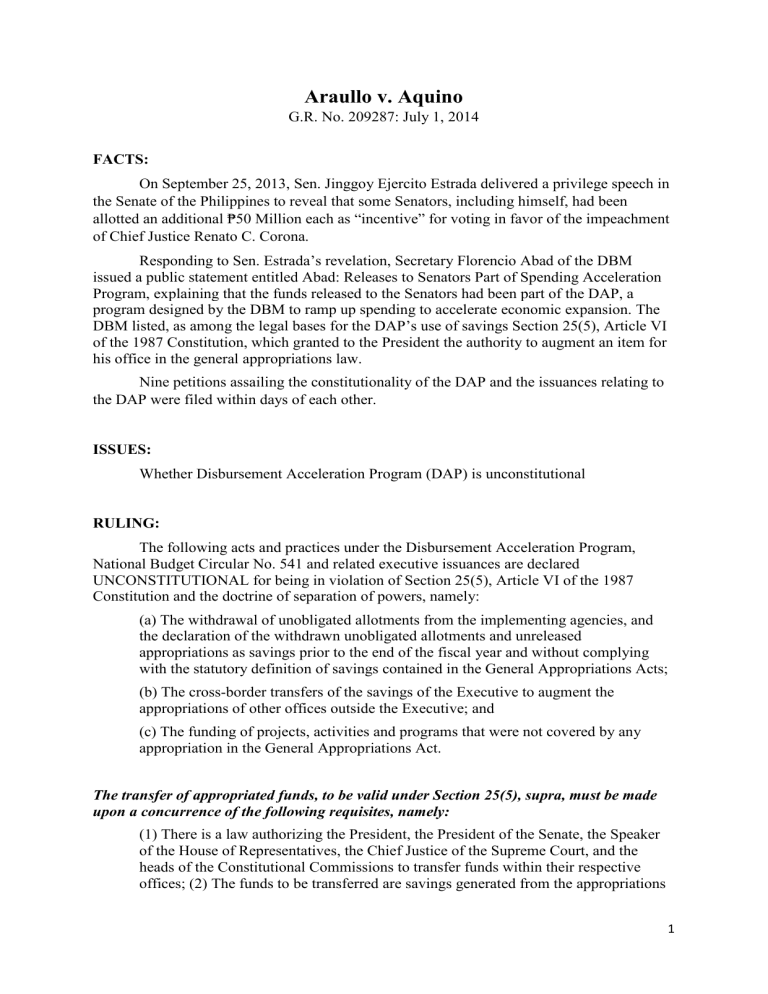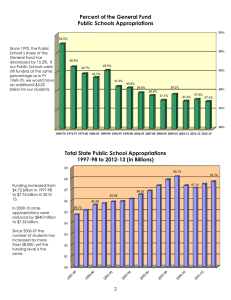
Araullo v. Aquino G.R. No. 209287: July 1, 2014 FACTS: On September 25, 2013, Sen. Jinggoy Ejercito Estrada delivered a privilege speech in the Senate of the Philippines to reveal that some Senators, including himself, had been allotted an additional ₱50 Million each as “incentive” for voting in favor of the impeachment of Chief Justice Renato C. Corona. Responding to Sen. Estrada’s revelation, Secretary Florencio Abad of the DBM issued a public statement entitled Abad: Releases to Senators Part of Spending Acceleration Program, explaining that the funds released to the Senators had been part of the DAP, a program designed by the DBM to ramp up spending to accelerate economic expansion. The DBM listed, as among the legal bases for the DAP’s use of savings Section 25(5), Article VI of the 1987 Constitution, which granted to the President the authority to augment an item for his office in the general appropriations law. Nine petitions assailing the constitutionality of the DAP and the issuances relating to the DAP were filed within days of each other. ISSUES: Whether Disbursement Acceleration Program (DAP) is unconstitutional RULING: The following acts and practices under the Disbursement Acceleration Program, National Budget Circular No. 541 and related executive issuances are declared UNCONSTITUTIONAL for being in violation of Section 25(5), Article VI of the 1987 Constitution and the doctrine of separation of powers, namely: (a) The withdrawal of unobligated allotments from the implementing agencies, and the declaration of the withdrawn unobligated allotments and unreleased appropriations as savings prior to the end of the fiscal year and without complying with the statutory definition of savings contained in the General Appropriations Acts; (b) The cross-border transfers of the savings of the Executive to augment the appropriations of other offices outside the Executive; and (c) The funding of projects, activities and programs that were not covered by any appropriation in the General Appropriations Act. The transfer of appropriated funds, to be valid under Section 25(5), supra, must be made upon a concurrence of the following requisites, namely: (1) There is a law authorizing the President, the President of the Senate, the Speaker of the House of Representatives, the Chief Justice of the Supreme Court, and the heads of the Constitutional Commissions to transfer funds within their respective offices; (2) The funds to be transferred are savings generated from the appropriations 1 for their respective offices; and (3) The purpose of the transfer is to augment an item in the general appropriations law for their respective offices. The 4 acts and practices under the DAP that violated the provisions of Section 29 (1), Art. VI and Section 25 (5), Art. VI of the Constitution 1) First Requisite–GAAs of 2011 and 2012 lacked valid provisions to authorize transfers of funds under the DAP; hence, transfers under the DAP were unconstitutional. A reading shows that the aforequoted provisions of the GAAs of 2011 (Sec. 52) and 2012 (Sec. 59) were textually unfaithful to the Constitution for not carrying the phrase “for their respective offices” contained in Section 25(5) of Article VI of the Constitution. The impact of the phrase “for their respective offices” was to authorize only transfers of funds within their offices (i.e., in the case of the President, the transfer was to an item of appropriation within the Executive). The provisions carried a different phrase (“to augment any item in this Act”), and the effect was that the 2011 and 2012 GAAs thereby literally allowed the transfer of funds from savings to augment any item in the GAAs even if the item belonged to an office outside the Executive. To that extent did the 2011 and 2012 GAAs contravene the Constitution. At the very least, the aforequoted provisions cannot be used to claim authority to transfer appropriations from the Executive to another branch, or to a constitutional commission. 2) Second Requisite – There were no savings from which funds could be sourced for the DAP. Funds should meet the statutory definition of “savings” as defined by the Congress in General Approriation Laws before they may rightfully be considered as “savings.” 3) Third Requisite – No funds from savings could be transferred under the DAP to augment deficient items not provided in the GAA. An appropriation for any PAP must first be determined to be deficient before it could be augmented from savings. Upon careful review of the documents contained in the seven evidence packets, the Court conclude that the “savings” pooled under the DAP were allocated to PAPs that were not covered by any appropriations in the pertinent GAAs. 4) Third Requisite – Cross-border augmentations from savings were prohibited by the Constitution. The records show, indeed, that funds amounting to ₱143,700,000.00 and ₱250,000,000.00 were transferred under the DAP respectively to the COA and the House of Representatives. The definition of “savings” in the GAAs, particularly for 2011, 2012 and 2013, reflected this interpretation and made it operational, viz: Savings refer to portions or balances of any programmed appropriation in this Act free from any obligation or encumbrance which are: (i) still available after the completion or final discontinuance or abandonment of the work, activity or purpose for which the appropriation is authorized; (ii) from appropriations balances arising from unpaid compensation and related costs pertaining to vacant positions and leaves of absence without pay; and (iii) from appropriations balances realized from the implementation of measures resulting in improved systems and efficiencies and thus enabled agencies to meet and deliver the required or planned targets, programs and services approved in this Act at a lesser cost. 2

